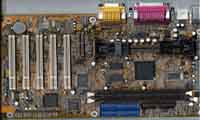A new chipset, a new set of motherboards, it's about time Intel released the 810 chipset, the motherboard market was getting boring very quickly. With their claim to fame as being the first manufacturer with a widely available i810 based motherboard, DFI is betting that their PW65-D will enjoy the benefits of being the first 810 board on the market. Unfortunately, the lack of information about the 810 chipset, and the general fear of the infant 810 motherboard market will keep sales of this board somewhat lower than expected. When dealing with releasing the first motherboard based on a completely new chipset design, as a manufacturer, you don't benefit from being the first, rather you benefit from entering the market as the best out of a group of initial risk takers. Taking the plunge on your own is not the most profitable course of action for a motherboard manufacturer, but from a user's perspective, if the motherboard is high in quality then the company's business plan doesn't really come into sight now does it?
How well will the PW65-D satisfy your needs as the first readily available 810 based motherboard? With a new set of standards, let's see how the DFI board fares in AnandTech's first close look at an 810 based motherboard.
New Anand Tech Report Card Rating 75/D+
| CPU Interface | Slot-1 |
| Chipset | Intel 810-DC100 |
| On-Board Video | 810-DC100 GMCH |
| I/O Controller | 801 ICH |
| L2 Cache | N/A (on-chip) |
| Form Factor | ATX |
| Bus Speeds | 66 / 100 |
| Clock Multipliers | 1.5x - 7.5x |
| Voltages Supported | 2.8v / 2.0v (Auto-Detect) |
| Memory Slots | 2 168pin DIMM Slots |
| Expansion Slots | 0 AGP Slot 1 AMR Slot 5 PCI Slots (5 Full Length) 0 ISA Slots |
| BIOS | Award BIOS |
The Good
| PC99 compliance is here guys 'n gals, and the 810 boards will be the first in line to show off the new specification. The PC99 specification first calls for a "Packard Bell-ish" color coding system of the rear ATX I/O ports, as scary as this may sound, your favorite motherboards in a few months will be boasting this same color code. The reason behind that is simply to make things easier for the novice, which isn't a bad thing to do at all, just get used to the bright new colors. | |
| The expansion slot
configuration of the PW65-D is also inspired by the PC99 specification, the absence of any
ISA slots being the tip in that case. The board features a soon to be commonplace
1/5/0 expansion slot configuration (AMR/PCI/ISA), and maxes out the 810's chipset
limitation by including 2 SDRAM banks for memory expansion. The layout of the board was done quite intelligently, with the front panel LED/switch connectors bent towards the front of the motherboard, therefore allowing all 5 PCI slots to accept full length PCI cards. The ATX power supply connector is placed out of the way to the far right of the PCB, and the SC242 (Slot-1) connector features a universal CPU retention bracket that goes along with the P2/P3/Celeron compatibility motif the PW65-D boasts. The board features a multitude of power indicator LEDs, one that indicates whether or not the board is receiving power, one that indicates whether the memory banks are receiving power (comes in handy when the new Suspend to RAM feature is used), and one that indicates when the CPU is receiving power. The LEDs are very helpful especially if you're prone to installing components while a computer is running, it's not as rare an occurrence as you may think. |
|
At the heart of the PW65-D is the Intel 810-DC100 Graphics and Memory Controller Hub (GMCH), the 'DC100' extension indicating the presence of the 4MB - 100MHz Display Cache. The two SDRAM chips that make up the 4MB display cache are manufactured by Samsung and are SEC's '-G8' chips (K416S1020CT-G8). The Award BIOS setup allows for the DC frequency to be adjusted from the standard 100MHz to the "overclocked" 133MHz setting for a small performance boost. The PW65-D makes use of the 801AA I/O Controller Hub (ICH) meaning the board is capable of taking advantage of up to 6 PCI master slots and supports the Ultra ATA 66 specification.
The Award BIOS v6.00PG setup utility located on the Firmware Hub (FWH) of the PW65-D powers a fully jumperless CPU setup. The clock generator on the PW65-D supports the standard 66/100MHz FSB frequencies, in addition to the 75/83/95/112/117/124/133/138/143/150MHz settings. Courtesy of the 810 chipset, the memory bus always operates at 100MHz regardless of the FSB frequency resulting in the increased ability to overclock due to a lack of dependence on the quality of your SDRAM. The Award BIOS setup features a handful of options including the ability to enable/disable the AC'97 codecs on-board, set DC latency timings, and configure such options as the Processor Serial Number enable/disable.
Included with the PW65-D is a standard drivers/utility CD as well as the User's Manual. The bundled CD contains all the necessary drivers, directly from Intel, required to get your system up and running. The Manual provides basic documentation as to the features and capabilities of the motherboard, nothing too special there.











0 Comments
View All Comments